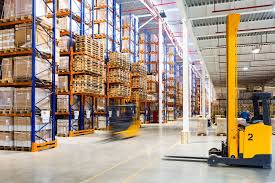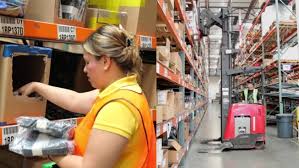Guide to packing & loading
Loading your moving truck can seem like a daunting task, but by making use of every nook and cranny available, you can avoid making multiple trips and help prevent delicate items from shifting during transit. Follow our helpful tips for optimising space, and be surprised at just how stress-free moving can be.
Large appliances and whitegoods
The first items to go on board will be your large appliances and whitegoods. These large items will form a foundation for you to pack your belongings around, and are shaped perfectly and sturdy enough for boxes to go on top.
Be sure to completely defrost your refrigerator and drain your washing machine to avoid any unwanted water damage. Once your appliances are loaded onto your truck, carefully wrap them in moving pads and strap them in nice and tight to avoid any movement whatsoever.
Packing boxes
Packing boxes are not only great for keeping your belongings secure, they’re also perfect for getting the most space out of your truck rental. After you’ve loaded your heavy appliances onto the truck, we recommend stacking your packing boxes evenly from the floor to the ceiling, starting with the heaviest boxes first and using your appliances as a base where necessary.
Large and heavy furniture
Once you have your packing boxes stacked evenly, it’s time to start loading your heavy furniture on board. To avoid wasting space, it’s important to carefully prepare these items for transport with the use of moving pads and packing straps.

Guide to Moving During a Pandemic
know the struggle of packing up basically your entire life in boxes and moving (all while wearing a mask that can get pretty toasty). If you’re moving soon, fear not, as this guide will help you navigate the beginnings of your new life in a new borough — or a new street if you’re just moving a few blocks over.
Be WiFi-enabled on day 1
Since a lot of people are working from home these days, the last thing you want is to have to wait until the day after you’ve moved in to have access to the Internet. Make sure you schedule your WiFi installation in advance, preferably on the day of your move so you’ll be able to relax with Netflix after you procrastinate on unpacking.
Measure the doors and spaces of your new apartment
With the pandemic still around, a lot of realtor companies aren’t allowing in-person showings before you move in, so it’s likely that you had to rely on photos, virtual tours, and awkward video tours to decide on where your next place of residence would be. A pesky side effect of this, however, is that you won’t really know the measurements and dimensions of the space until you get there.
Purge your apartment of everything you haven’t used in the last six months
It’s time to be discerning. You probably don’t need the cumbersome armchair in the corner that no one sits on… ever. And you definitely don’t need that record player that looks like a suitcase that you got at Urban Outfitters. Instead of throwing them away, donate them, sell them on an app, or put up flyers in your building and have a good old-fashioned, socially distanced stoop sale. The less stuff you have to move, the cheaper and less time-consuming moving day will be.
Secure packing supplies…
For reliably sturdy and new boxes, City Moving Boxes sells boxes and rents reusable ones with free same-day delivery. With Bin It, a mini-storage system, a set of stackable plastic bins will be dropped off at your place, and picked up at your new pad after your move two-to-four weeks later. also sells cardboard moving kits/boxes by the piece.

How to load and drive a moving truck
First, ensure there is parking available for the truck, as close as possible to the premises. recommends using a walk-up ramp if possible. “A walk-up ramp allows you to walk in and out of the truck each time. A tail lifter is often slow and inefficient,” she says.
“It’s best if the most commonly-used boxes for moving are used and that the boxes are packed professionally, so they’re not too heavy and are easy to move,” she says. Big wardrobes go in the truck first, says. “Place a soft tie around the entire wardrobe, to stop the door from coming open. I load from the front of the truck, on the right-hand side, facing the doors to the wall, then covering the doors with a furniture pad to completely protect it,”
Try to keep the height, from right to left, even. “The next obvious (thing to load) would be a lounge. I wrap it in a plastic before it leaves the house, then stand it beside and behind the back of the wardrobe. Place it on a blanket on the floor and then wrap another one around it.”
Put cushions or light objects on top of the wardrobe and lounge, to fill the void to the roof. Next, the fridge, washing machine or dryer goes in, to maintain the height, then again put lighter items on top. “The next two layers deep, working from front to back, I start right to left again, and I may put two tea chests in height then two book cartons on top, this allows me to fill all the space evenly and give me a level platform for loading dining chairs on top,”
“Each chair is wrapped in a pad, then married inside to another, so they fit tight. The first one goes on its back, with legs to the right, then the next one inside and so on. This will fill the space level and tight to the roof. I keep working layers back, bigger and heavier items at the bottom and lighter items on top from right to left,” she says.

Tips for loading and unloading your truck
You are in the process of relocation. you have done all the research you can to locate the most suitable moving company and you have even followed professional instructions and have completed packing your goods like a pro. Now the moving day has arrived and even the truck has arrived at your front door. It is time to load.
Getting the shivers? Not when you go through these tips for loading and unloading your truck:
After you have completed packing, the first thing you need to do is to walk round the house and keep the similar sized boxes together. This makes loading faster.
Load the heaviest items first. Items like oven, cooking range, washing machine, refrigerator, dishwasher etc are loaded first. Basically, any item which takes two or more people to move are called ‘heavy’ here. These items should be kept at the wall furthest away, close to the cab. All items must be kept in the upright position.
The moving truck must be loaded with equal weight on either side.
Use furniture padding (available on rent) to protect furniture legs, corners and surfaces.
Your next items to load are the long and big items like headboards, mirrors, mattresses, etc. Sofas and table tops also fall in this category. These items should be loaded so that they stay upright against the longer walls of the truck. This will help you save some space.
Bed frames should be dissembled and taped together. This should be done for other long items like skis and poles
Tips For Packing
Carpets, rugs must be rolled and taped together. These can be placed at the center of the truck floor.
During loading place the heaviest boxes on top of the appliances. Then smaller boxes can be stacked one on top of the other.
Make sure that all empty spaces like beneath the tables, desks and cabinets must be properly filled with blankets, padding and linen. This will prevent your goods being tossed around during journey.
Amongst all the boxes which you stack, keep the lightest boxes on top. This will help you unload faster.
All fragile items and items with odd shapes must be loaded last.
The thumb rule of loading a truck is that you must load the ‘most essential’ boxes last. For instance, boxes containing your bed linen, your immediate change of clothes, bare minimum kitchen utensils and your bathroom contents need to be loaded last, as these are items which you should unload first. Remember, your first night at your new home, will demand use of these items.
During unloading, follow the same schedule as you did while loading. In fact, unloading becomes much simpler if you have loaded properly in the first place. For instance, if you have marked the bedroom moving boxes with blue sticker, children’s room with yellow stickers, when you unload, the individually sticker boxes can immediately be taken to the appropriate rooms.
Moving During Coronavirus? What to Expect and How to Protect Yourself
Roughly 80% of people who move every year do so between the months of April and September. That puts the coronavirus outbreak hitting the U.S. precisely before — you guessed it — peak moving season. While some people can delay or cancel their move, anyone who recently sold a home does not have the ability to change plans easily. Their move date is tied to their closing date, and one way or another, they need to find a way to be out on time.
Moving services are considered essential, but prepare for delays
People selling homes aren’t the only ones in this situation. It also applies to anyone who bought a house or has a strict lease. The Feds have deemed moving an essential service, and generally individual states and municipalities have followed suit. That means you can still rent a moving truck, hire professional movers, arrange for a shipping container, or line up any of the moving services you need.
However, moving — like everything else — looks a lot different than it did pre-coronavirus, and you could face backed-up mover schedules or unexpected delays. Fortunately, large moving companies remain open and are adapting to these new circumstances to help customers move as safely as possible.
Decide how you want to move
Off the bat, you’ll have to decide how you want to move. Some methods might prove more challenging than others when it comes to social distancing. Full-service moves are going to involve more contact with others than a DIY or shipping container move where you load up your furniture yourself. Your decision should be based on the traditional moving criteria: How much stuff you have, how far you’re moving, what your budget looks like. But now there’s another factor to consider: What’s the safest way for me
DIY your move
Movers on a budget facing a local move might opt to do the entire move on their own, using their own vehicle and manpower to save a bundle of cash. Just remember, in the time of social distancing, you won’t be able to call on friends or neighbors for assistance. This is a true do-it-yourself route that cuts out any interactions.


